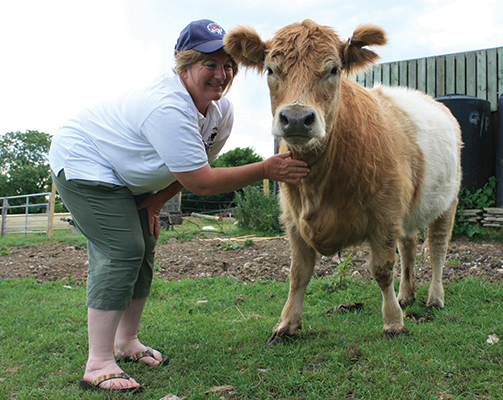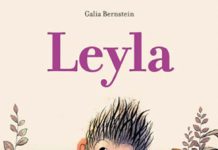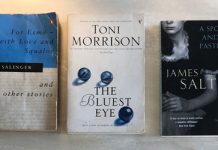 Out in the fields, the cattle are moving slowly, chomping on grass, wild honeysuckle and anything that takes their fancy.
Out in the fields, the cattle are moving slowly, chomping on grass, wild honeysuckle and anything that takes their fancy.
They’re a cheery looking bunch, these Belted Galloways, and come in three colours—black, dun and red, and each with a band of white encircling their bellies. They belong to Darlene and Patrick Ford who, in five years, have gone from two to nineteen head of cattle, and picking up armfuls of rosettes and trophies from local agricultural shows and The Bath and West Show along the way.
‘The first ones we bought because I liked the look of the breed,’ Patrick says, as he gazes over the gate towards the Belties, as they’re affectionately known. ‘The guy we bought them was from Dartmoor. He was really enthusiastic about the breed.’
Up until that point, the couple, who both work fulltime (Darlene for Magna Housing Association and Patrick as a builder) had a mixed herd of Hereford/Devon X on their smallholding at Frome Vauchurch, near Dorchester, for the past 26 years. They still have Bella, a 20-year-old Friesian/Hereford X, who is a steadying influence on some of the young members of the Norden Herd.
‘At first, we were just going to have a couple of unregistered ones,’ recalls Darlene. ‘But, at the time, we’d had a TB test on our own cattle and one had come back inconclusive, although the cow passed when it had a second test. We looked at the level of compensation and for a non-pedigree Belted Galloway it was about £800 and for pedigree around £1,800. So we thought, pedigree or not, they would still cost the same to keep. So we bought two and looked at showing them. Then we went back and bought his best heifer.’
The Belted Galloway is a hardy beef breed originating from Galloway in the west side of southern Scotland. Once on the endangered list and still a rare breed, Belties are enjoying an upsurge in popularity.
According to The Belted Galloway Society, ‘the Beltie is well-equipped to thrive outdoors in any climate. This remarkable animal is slow to mature, which means its beef has a special flavour and texture which is the envy of many other breeds. The cows live far longer than other cattle often well into their twenties, producing more calves and reducing replacement costs.’
Says Darlene: ‘They over-winter out in Scotland. They have unique fur—a long and shaggy outer coat and a very fine one underneath. They don’t have a layer of fat under the skin and produce lovely, marbled beef, which is much lower in cholesterol than other breeds.’
It will be a busy couple of months for Darlene and Patrick as they prepare for The Melplash Show at the end of this month and Dorchester Show and the Frome Cheese Show in September.
‘We start preparing for the Melplash Show about three weeks before,’ Darlene says. ‘The cattle are washed and blow dried about five times before they go to the show. We do that in the evenings and at weekends. Halter training is ongoing and they are regularly tied up and then walked, this is the hardest part of showing cattle, they must behave in the show ring. The night before, everything’s lined up on the drive: bales of hay, all the grooming kit, picnic chairs, buckets, the gazebo. And then we send up a prayer and hope they haven’t lain or rolled in anything.’
Thankfully, their children Kristen 29 and Paul 27 help out. Paul helps with the stock, while Kristen provides picnic and clipboard to keep them in check. Their granddaughter Ellie-mai 8 helped in the grand parade at Melplash last year.
‘We set off at about 6.30am and aim to be there at about 7.30,’ Darlene says. ‘Then, when we get there, we start giving them a little fluff up and then settle them in. And then we have to get changed and start to bring the cattle out. The morning is pretty full on, showing, and then, once the gates are opened, we’re inundated by the public, who love them. Then it’s the grand parade and when it’s time to go, we let the others, who have farther to travel, go first and then we can relax a little bit.’
Their bull, Otto, is off to Exmoor shortly to make way for little Benedict, 18-months-old now but waiting in the wings to head the herd. He’s already a trophy winner, picking up awards at Melplash last year where he won first place for bull any age (he was only seven months old); Dorset County Show where he was placed second for bull of any age (he was just months) and at this year’s Royal Bath & West where he was awarded first place for junior bull and reserve champion.
‘He’s a very placid animal,’ Patrick says. ‘We’ve spent a lot of time halter training him and it’s very satisfying having a bull you’ve bred yourself.’
Says Darlene: ‘We’re quite excited about Benny. The showing is great and it’s great promotion for the breed but they are working animals—we need the bulls to perform and the cows to be in calf. Our aim is to produce good quality breeding heifers for sale and top end beef to sell.’









